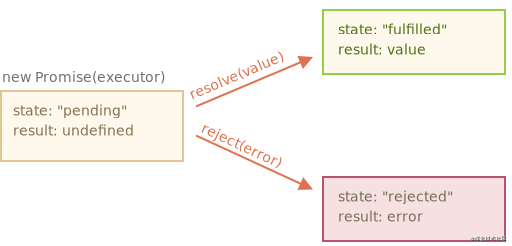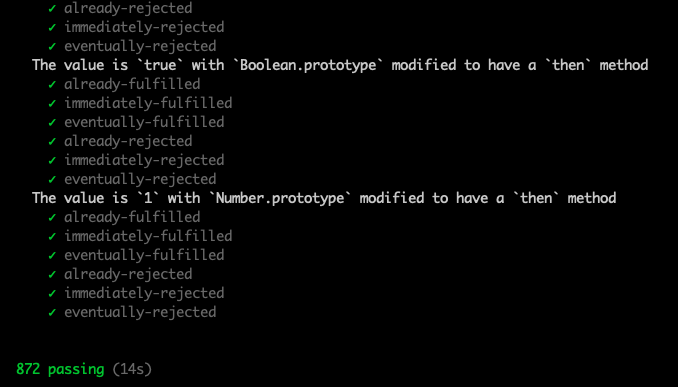按 PromisesA+规范实现一个 Promise (TypeScript版)
1. 前言
之前用 ES6 实现了一个 Promise,详见这里。 本次用 TS 再实现一个,基本思路是一样的。可以先理解这篇文章后,再看本篇,会更易理解。
Promise/A+ 规范详见这里。
环境准备
因为基于 TS 开发,浏览器不能直接运行,所以需要有构建环境,配置如下:
// package.json
{
"scripts": {
"watch": "tsc -w"
},
"dependencies": {},
"devDependencies": {
"@types/node": "^15.12.0",
"typescript": "^3.7.0"
}
}// tsconfig.json
{
"compileOnSave": false,
"compilerOptions": {
"baseUrl": ".",
"outDir": "./dist",
"sourceMap": true,
"declaration": true,
"module": "esnext",
"moduleResolution": "node",
"target": "es5",
"allowJs": true,
"lib": ["es6", "dom", "es2016", "es2017", "es2018", "es2019", "es2020"],
"paths": {},
"downlevelIteration": true,
"typeRoots": ["./node_modules/@types/", "./typings.d.ts"]
},
"include": ["src/**/*"],
"exclude": ["node_modules", "dist", "**/*.spec.ts"],
"typeAcquisition": {
"include": []
}
}实时构建:
npm run watch2. Promise 介绍
2.1 Promise 内部状态
Promise 的核心思想是 Promise 表示异步操作的结果。一个 Promise 处于以下三种状态之一:
pending-Promise的初始化状态;fulfilled- 表示Promise成功操作的状态;rejected- 表示Promise错误操作的状态;
Promise 的内部状态改变如图所示:

2.2 Promise 的出现解决了什么问题
- 嵌套地狱的问题
在 Promise 没有出现之前,我们会看到很多类似的代码:
const fs = require('node:fs');
const filename = './test.txt';
fs.readFile(filename, 'utf8', (err, data) => {
if (err) {
console.error(err);
}
else {
fs.readFile(filename, 'utf8', (err, data) => {
if (err) {
console.error(err);
}
else {
fs.readFile(filename, 'utf8', (err, data) => {
if (err) {
console.error(err);
}
else {
console.log(data);
}
});
}
});
}
});Promise 出现之后,就可以采用链式调用的形式来写:
const fs = require('node:fs');
const filename = './test.txt';
function readFile(filename) {
return new Promise((resolve, reject) => {
fs.readFile(filename, 'utf8', (err, data) => {
if (err) {
reject(err);
}
else {
resolve(data);
}
});
});
}
readFile(filename)
.then(() => {
return readFile(filename);
})
.then(() => {
return readFile(filename);
})
.then((data) => {
console.log(data);
})
.catch((err) => {
console.error(err);
});使用了 Promise 之后代码风格变得优雅了很多,写法上也更加直观。
- 支持多个异步请求并行处理
Promise.all更加方便的处理多个任务完成时再进行处理的逻辑;Promise.race更加方便的处理最早任务完成时再进行处理的逻辑;- ...
3. 根据 Promise/A+ 规范实现 Promise
3.1 基本功能实现
在动手写代码之前先了解一下需要实现哪些功能:
Promise constructor
new Promise 时,构造函数需要传入一个 executor() 执行器,executor 函数会立即执行,并且它支持传入两个参数,分别是 resolve 和 reject。
class Promise<T> {
constructor(executor: (resolve: (value: T) => void, reject: (reason?: any) => void) => void) {
}
}Promise状态「Promise/A+ 2.1」
Promise 必须处于以下三种状态之一:
pending(等待中),可以转换为fulfilled(完成)或rejected(拒绝)。- 当状态从
pending切换到fulfilled时,该状态不得再过渡到其它状态,并且必须具有一个值,该值不能更改。 - 当状态从
pending切换到 rejec`ted 时,该状态不得再过渡到其它状态,并且必须有一个失败的原因,不能更改。
Promise then方法「Promise/A+ 2.2」
Promise 必须有一个 then 方法,then 接收两个参数,分别是成功时的回调 onFulfilled,和失败时的回调 onRejected。
onFulfilled 和 onRejected 是可选的参数,并且如果传入的 onFulfilled 和 onRejected 不是函数的话,则必须将其忽略。
如果 onfulfilled 是一个函数。则它必须在 Promise 的状态变成 fulfilled(完成)时才能调用,Promise 的值是传进它的第一个参数。 并且它只能被调用一次。
如果 onRejected 是一个函数,则它必须在 Promise 的状态为 rejected(失败)时调用,并把失败的原因传入它的第一个参数。 并且它只能被调用一次。
既然知道了需要实现那些功能,那就来动手操作一下,代码如下:
// 使用枚举定义 Promise 的状态
enum PROMISE_STATUS {
PENDING,
FULFILLED,
REJECTED,
}
class _Promise<T> {
// 保存当前状态
private status = PROMISE_STATUS.PENDING;
// 保存 resolve 的值,或者 reject 的原因
private value: T;
constructor(executor: (resolve: (value: T) => void, reject: (reason: any) => void) => void) {
executor(this._resolve, this._reject);
}
// 根据规范完成简易功能的 then 方法
then(onfulfilled: (value: T) => any, onrejected: (value: any) => any) {
// 2.2.1
onfulfilled = typeof onfulfilled === 'function' ? onfulfilled : null;
onrejected = typeof onrejected === 'function' ? onrejected : null;
if (this.status === PROMISE_STATUS.FULFILLED) {
// 状态为 fulfilled 时调用成功的回调函数
onfulfilled && onfulfilled(this.value);
}
if (this.status === PROMISE_STATUS.REJECTED) {
// 状态为 rejected 时调用失败的回调函数
onrejected && onrejected(this.value);
}
}
// 传入 executor 方法的第一个参数,调用此方法就是成功
private _resolve = (value) => {
if (value === this) {
throw new TypeError('A promise cannot be resolved with itself.');
}
// 只有是 pending 状态才可以更新状态,防止二次调用
if (this.status !== PROMISE_STATUS.PENDING) { return; }
this.status = PROMISE_STATUS.FULFILLED;
this.value = value;
};
// 传入 executor 方法的第二个参数,调用此方法就是失败
private _reject = (value) => {
// 只有是 pending 状态才可以更新状态,防止二次调用
if (this.status !== PROMISE_STATUS.PENDING) { return; }
this.status = PROMISE_STATUS.REJECTED;
this.value = value;
};
}
export { _Promise };代码写完了我们测试一下功能:
<!doctype html>
<html lang="en">
<head>
<meta charset="UTF-8" />
<meta http-equiv="X-UA-Compatible" content="IE=edge" />
<meta name="viewport" content="width=device-width, initial-scale=1.0" />
<title>Promise测试</title>
</head>
<body>
<script type="module">
import { _Promise } from "../../dist/example/index1.js";
const p1 = new _Promise((resolve, reject) => {
resolve(1);
});
p1.then((res) => {
console.log(res, "then ok 1");
});
const p2 = new _Promise((resolve, reject) => {
setTimeout(() => {
resolve(2);
}, 1000);
});
p2.then((res) => {
// 不支持异步
console.log(res, "then ok 2");
});
</script>
</body>
</html>控制台会打印出:
1 "then ok 1"不错,现在已经是稍见雏形。
3.2 支持异步操作
我们已经实现了一个入门级的 Promise,但是细心的同学应该已经发现了,then ok 2 这个值没有打印出来。
导致这个问题出现的原因是什么呢? 原来是我们在执行 then 函数的时候,由于是异步操作,状态一直处于 pending 的状态,传进来的回调函数没有触发执行。
知道了问题就好解决了。 只需要把传进来的回调函数存储起来,在调用 resolve 或 reject 方法的时候执行就可以了。 我们优化一下代码:
class _Promise<T> {
// ...
// 保存 then 方法传入的回调函数
private callbacks = [];
// ...
// 根据规范完成简易功能的 then 方法
then(onfulfilled: (value: T) => any, onrejected: (value: any) => any) {
// ...
// 把 then 方法传入的回调函数整合一下
const handle = () => {
if (this.status === PROMISE_STATUS.FULFILLED) {
// 状态为 fulfilled 时调用成功的回调函数
onfulfilled && onfulfilled(this.value);
}
if (this.status === PROMISE_STATUS.REJECTED) {
// 状态为 rejected 时调用失败的回调函数
onrejected && onrejected(this.value);
}
};
if (this.status === PROMISE_STATUS.PENDING) {
// 当状态是 pending 时,把回调函数保存进 callback 里面
this.callbacks.push(handle);
}
handle();
}
}在来测试一下上面的代码:
const p2 = new _Promise((resolve, reject) => {
setTimeout(() => {
resolve(2);
}, 1000);
});
p2.then((res) => {
console.log(res, 'then ok 2');
});在等待 1s 后,控制台会打印出:
2 "then ok 2"目前已经可以支持异步操作了。
3.3 then 方法的链式调用
在文章一开头介绍 Promise 时,提到了链式调用的概念 .then().then() ,现在就要实现这个至关重要的功能,在开始前先看一下 Promise/A+ 的规范:
then 必须返回一个 Promise。「Promise/A+ 2.2.7」)
promise2 = promise1.then(onFulfilled, onRejected);如果一个 onFulfilled 或 onRejected 返回一个值 x,则运行 Promise Resolution Procedure (会在下面实现这个方法)。
如果任何一个 onFulfilled 或 onRejected 引发异常 e 则 promise2 必须以 e 为其理由 reject (拒绝)。 如果 onFulfilled 不是函数且 promise1 状态已经 fuifilled(完成),则 promise2 必须使用与相同的值来实现 promise1。 如果 onRejected 不是函数而 promise1 状态为 rejected(拒绝),则 promise2 必须以与相同的理由将其拒绝 promise1。
Promise Resolution Procedure 实现
首先该方法的使用方式类似于下面这种形式:
// resolvePromise(promise, x, ...)如果 promise 和 x 引用相同的对象,promise 则应该以 TypeError 为理由拒绝。「Promise/A+ 2.3.1」
如果 x 是一个 promise,则应该采用它原本的状态返回。「Promise/A+ 2.3.2」
否则,判断 x 如果是对象或者是函数,则执行以下操作:
先声明 let then = x.then ,如果出现异常结果 e ,则以 e 作为 promise reject(拒绝)的原因。 如果 then 是个函数,则用 call 执行 then ,把 this 指向为 x ,第一个参数用 resolvePromise 调用,第二个用 rejectPromise 调用。「Promise/A+ 2.3.3」 如果 x 不是对象或者方法,则使用 x 的值 resolve 完成。「Promise/A+ 2.3.4」
只是通过文字不太容易理解,我们来看一下代码的实现:
class _Promise<T> {
// ...
// 根据规范完成简易功能的 then 方法
then(onfulfilled: (value: T) => any, onrejected: (value: any) => any) {
// ...
const nextPromise = new _Promise((nextResolve, nextReject) => {
// 把 then 方法传入的回调函数整合一下
const handle = () => {
if (this.status === PROMISE_STATUS.FULFILLED) {
// 状态为 fulfilled 时调用成功的回调函数
const x = onfulfilled && onfulfilled(this.value);
this._resolvePromise(nextPromise, x, nextResolve, nextReject);
}
if (this.status === PROMISE_STATUS.REJECTED) {
// 状态为 rejected 时调用失败的回调函数
if (onrejected) {
const x = onrejected(this.value);
this._resolvePromise(nextPromise, x, nextResolve, nextReject);
}
else {
nextReject(this.value);
}
}
};
if (this.status === PROMISE_STATUS.PENDING) {
// 当状态是 pending 时,把回调函数保存进 callback 里面
this.callbacks.push(handle);
}
else {
handle();
}
});
return nextPromise;
}
// ...
private _resolvePromise = <T>(nextPromise: _Promise<T>, x: any, resolve, reject) => {
// 2.3.1 nextPromise 不能和 x 相等
if (nextPromise === x) {
return reject(new TypeError('The promise and the return value are the same'));
}
// 2.3.2 如果 x 是 Promise 返回 x 的状态和值
if (x instanceof _Promise) {
x.then(resolve, reject);
}
// 2.3.3 如果 x 是对象或者函数执行 if 里面的逻辑
if (typeof x === 'object' || typeof x === 'function') {
if (x === null) {
return resolve(x);
}
// 2.3.3.1
let then;
try {
then = x.then;
}
catch (error) {
return reject(error);
}
// 2.3.3.3
if (typeof then === 'function') {
// 声明 called 在调用过一次 resolve 或者 reject 之后,修改为 true ,保证只能调用一次
let called = false;
try {
then.call(
x,
(y) => {
if (called) { return; } // 2.3.3.3.4.1
called = true;
// 递归解析的过程(因为可能 promise 中还有 promise)
this._resolvePromise(nextPromise, y, resolve, reject);
},
(r) => {
if (called) { return; } // 2.3.3.3.4.1
called = true;
reject(r);
}
);
}
catch (e) {
if (called) { return; } // 2.3.3.3.4.1
// 2.3.3.3.4
reject(e);
}
}
else {
// 2.3.3.4
resolve(x);
}
}
else {
// 2.3.4
resolve(x);
}
};
}目前已经实现可以链式调用的功能了,我们来测试一下:
const p3 = new _Promise((resolve, reject) => {
setTimeout(() => {
resolve(3);
}, 1000);
});
p3.then((res) => {
console.log(res, 'then ok 3.1');
return '链式调用';
}).then((res) => {
console.log(res, 'then ok 3.2');
});等待 1s 之后,控制台会打印出:
3 "then ok 3.1"
链式调用 then ok 3.23.4 支持微任务
有没有同学想到还缺少了一个尤为重要的功能,那就是微任务。我们应该如何实现和内置 Promise 一样的微任务流程呢?
在 Web Api 里面有这样一个方法 MutationObserver。我们可以基于它实现微任务的功能。并且也已经有相关的库给我们封装好了这个方法,它就是 asap。只要把需要以微任务执行的函数传入即可。
asap(() => {
// ...
});其实在 Web Api 里面还有这样一个方法 queueMicrotask 可以直接使用。使用方式也是把要以微任务执行的函数传入进去即可。
// eslint-disable-next-line no-restricted-globals
self.queueMicrotask(() => {
// 函数的内容
});queueMicrotask 唯一的缺点就是兼容性不太好,在生产环境中建议还是使用 asap 这个库来实现微任务。
把之前写好的 Promise then 方法稍微做一下调整:
// ...
class _Promise<T> {
// ...
// 根据规范完成 then 方法
then(onfulfilled: (value: T) => any, onrejected: (value: any) => any) {
// ...
const nextPromise = new _Promise((nextResolve, nextReject) => {
// 把 then 方法传入的回调函数整合一下
const _handle = () => {
// ...
};
const handle = () => {
// 支持微任务
queueMicrotask(_handle);
};
// ...
});
// ...
}
// ...
}console.log('first');
const p1 = new _Promise((resolve) => {
console.log('second');
resolve('third');
});
p1.then(console.log);
console.log('fourth');可以看到控制台打印的结果为:
first
second
fourth
third到这里,我们已经把
Promise最关键的功能完成了:支持异步操作,then 支持链式调用,支持微任务。
4. 测试完成的 Promise 是否符合规范
Promise/A+规范提供了一个专门的测试脚本promises-aplus-tests:
npm install -D promises-aplus-tests- 在我们的代码中加入以下代码:
;(_Promise as any).deferred = function () {
const dfd = {} as any;
dfd.promise = new Promise((resolve, reject) => {
dfd.resolve = resolve;
dfd.reject = reject;
});
return dfd;
};
module.exports = _Promise;- 修改
package.json文件增加以下内容(./dist/index.js是需要测试的文件路径):
// package.json
{
"scripts": {
"test": "promises-aplus-tests ./dist/index.js"
}
}- 执行
npm run test:

可以看到测试用例全部通过。
5. Promise 的其它 API 实现
到目前为止,上述代码已经完整的按照 Promise/A+ 规范实现了,但还有一些内置 Api 没有实现。 下面就把这些内置的方法来实现:
// ...
class _Promise<T> {
// ...
catch(onrejected) {
return this.then(null, onrejected);
}
finally(cb) {
return this.then(
value => _Promise.resolve(cb()).then(() => value),
reason =>
_Promise.resolve(cb()).then(() => {
throw reason;
})
);
}
static resolve(value) {
if (value instanceof _Promise) {
return value;
}
return new _Promise((resolve) => {
resolve(value);
});
}
static reject(reason) {
return new _Promise((resolve, reject) => {
reject(reason);
});
}
static race(promises) {
return new _Promise((resolve, reject) => {
if (!Array.isArray(promises)) {
return reject(new TypeError('Promise.race accepts an array'));
}
for (let i = 0, len = promises.length; i < len; i++) {
_Promise.resolve(promises[i]).then(resolve, reject);
}
});
}
static all(promises) {
const result = [];
let i = 0;
return new _Promise((resolve, reject) => {
const processValue = (index, value) => {
result[index] = value;
i++;
if (i === promises.length) {
resolve(result);
}
};
for (let index = 0; index < promises.length; index++) {
promises[index].then((value) => {
processValue(index, value);
}, reject);
}
});
}
static allSettled(promises) {
const result = [];
let i = 0;
return new _Promise((resolve, reject) => {
const processValue = (index, value, status: 'fulfilled' | 'rejected') => {
result[index] = { status, value };
i++;
if (i === promises.length) {
resolve(result);
}
};
for (let index = 0; index < promises.length; index++) {
promises[index].then(
(value) => {
processValue(index, value, 'fulfilled');
},
(value) => {
processValue(index, value, 'rejected');
}
);
}
});
}
}